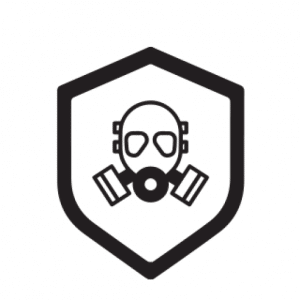Though you may not have control over when the power goes out, there are some things that you can do to stay warm during a winter power outage and prevent freezing.
Table of Contents
1. Prepare in Advance for the Power Outage
Plan now; don’t wait until the power goes out.
It’s important to make sure there are no flammables in the house that could spark during the power outage.
Have extra flashlights and candles ready, and have blankets and jackets stored away if it becomes necessary to keep everyone warm (Will talk about this in detail later).
1.1. Prepare the Heating Device
Prepare backup heating equipment or generator to get a heat source for the home during a power outage, and remember to read the device’s instructions to run the heaters you have safely.
While using any type of heating device, beware of the carbon monoxide poisoning that could be emitted.
Here are the types of heating devices and generators we can use when power outage:
1.1.1. Portable Generator
With this type of generator, you can quickly and easily connect to your home’s main electrical panel and power your devices. Additionally, you can run the generator with a smaller load and save fuel.
1.1.2. Electric Heater
They are plugged into a generator. It provides a small amount of heat when used for short periods.
1.1.3. Fireplace
This is only an option if you have a fireplace that works properly, and you’re able to get matches easily.
Fires require more attention than anything else, so be careful to not leave the fire unattended.
1.1.4. Gas Heater
You’ll need to make sure you have plenty of gas in your storage tank if you decide to go with this option.
Make sure any gas stove or furnace is cleaned and maintained regularly.
1.1.5. Solar Heaters
Are you able to set up a system with enough solar panels on your roof to provide enough heat for your home during the winter?
Solar-powered heaters can put out a high amount of heat, and having several in your home can be enough to keep everyone warm.
However, there are drawbacks regarding the space needed for these units as well as their cost.
1.2. Stockpile Blankets and Warm Clothing
Having extra blankets and a few other pieces of warm clothing ready is the best way to prevent freezing if there is no power, like blankets, jackets, hats, socks, and hand warmers.
Make sure you have at least one set of warm clothing for each person in the household.
Be sure to place your clean clothes and blankets in a safe area so that the weather or animals do not damage them during an emergency evacuation.
Vacuum sealed sleeping bags are also helpful to have on hand if you don’t want to clean out your closet right away after the power comes back on.
1.3. Stock Easy-To-Heat Foods and Beverages
Foods such as instant oatmeal and canned soup are easy to store, inexpensive, and very easy to reheat by bringing them up to a boil for a few minutes in a pot on the stovetop or in the microwave.
That being said, you should always be careful about food spoilage.
Keep an eye on cans of soup closely for rusting, leaking, or bulging lids before you open them up, and make sure they’re still sealed when you purchase them!
Water storage should be a priority for any emergency preparedness plan.
You should have enough water for three days worth of drinking, cooking, and hygiene supplies. Additionally, you should have emergency water filtration systems that can purify your water even if the power is out.
1.4. Prepare for the Light Source
Lack of light can be one of the most problematic aspects of a power outage, and it may have an emotional effect as well.
The situation can quickly get worse if you’re stuck in a dark house with no way to see what’s happening outside.
The best thing you can do is keep a few good flashlights near your bedside table and other places in the house like the living room or kitchen, where they’re easier to find when needed.
There are also some torches with rechargeable batteries that will keep going up for a very long time.
2. During Power Outage
Once you’re out in the cold, you have to take some precautions.
If you already get prepared in advance, then even if the power is off, you won’t be affected because you already have all the necessities in your home.
2.1. Put the Generator Running
It’s important to keep your living room warm.
If you have a generator, put it running.
Keep heating the living room as you prepare other elements of the house for heating.
2.2. Fire Up the Fireplace
If you have a fireplace, use it.
Fireplaces are great because they’re both warm and easy to light.
take extra care to ensure you never fall asleep with an open flame still fire.
2.3. Use the Portable Heater
Since portable heaters are not as efficient as a fireplace, use them sparingly.
2.4. Dress Warmly
It is essential to stay warm in below-freezing temperatures.
Wear the right clothes for the weather and layer up if necessary.
2.4.1. Dress in Layers
Wear several layers during the coldest months of the year.
It is better to be too warm than too cold.
A warm layer will keep you warmer next to your body, which can be important if you do not have a working heater or fireplace.
2.4.2. Dress for the Cold
A hat, scarf, or gloves can help keep your head and hands warm.
During the winter months, take care of your feet with warm socks and shoes.
2.5. Close All The Blinds and Curtains at Night
If weather conditions are too cold for you, make sure that any blinds and curtains are closed at night.
This will help to keep the heat leaks from your home and prevent cold air from entering.
2.6. Increasing Body Temperature
Increasing your body temperature is important to increase body warmth and be more comfortable in cold conditions.
You can increase your body temperature by exercising or drinking a warm liquid such as hot tea or hot chocolate can help warm your body.
In most situations, alcohol has a cooling effect on the body, but it can actually lead to hypothermia by lowering your core temperature, you are more prone to hypothermia and frostbite. Alcohol also increases blood flow to certain regions of your body which means less oxygen is reaching your extremities.
2.7. Close Rooms You Won’t Be Using
Close all the rooms and doors that you won’t need to use during this time.
This will ensure that heat does not escape your home.
2.8. Huddle In One Small Room
It is better to stay close together and huddle in one small room rather than have everyone throughout the house.
The body heat of the many people inside a house will warm up the area.
You don’t want to waste a lot of heat by heating multiple rooms when you can be more efficient and keep your family warm by staying in one small area.
2.9. Put Your Tent Up Indoors
Even if that means setting it up in your living room, it may help you stay warmer.
A tent will help to trap heat and keep it in your home.
It can also help to cut down the wind if the weather is really cold.
2.10. Pull Out Your Sleeping Bags
If you have sleeping bags or sweaters that have electric blankets, use them.
2.11. Insulate Windows
You can temporarily add insulation to your windows to keep heat inside your home.
Attaching a sheet of insulation or cardboard to the windows using tape can be one idea.
2.12. Unplug Unnecessary Electrical Equipment
Unplug any electrical equipment and appliances that are not currently in use.
Ensure that they don’t continue to use power when the power is back on and will save both money and energy.
2.13. Stay Hydrated
Cold weather can cause dehydration because you can lose a lot of fluid through sweat and breathing.
Make sure you stay hydrated and drink plenty of water.
3. What to do when the power comes on
3.1. Plan Your Priority
A good way to see what’s urgent is to take the post-outage checklist and prioritize it according to importance.
However, you may need to replace broken items or even check in with your utility company while things are still out of order, so don’t be afraid to get in touch with them while your house is still cold!
3.2. Do a Quick Inspection
Your generator, gas line, plugs, and water heater should be checked immediately after the power comes back.
If you have some damage to these elements, you need to fix them.
3.3. Check the Condition of Your Appliances
It’s a good idea to check your appliances before using them after the power comes back on.
Now is a good chance to repair broken ones or replace old ones with newer models! Get help from an electrician if needed.
3.4. Stock Up
If you have missed a few grocery shopping trips in the past weeks, it’s time to stock up on groceries and other essentials.
This is especially true if you have been eating a lot of canned soups and crackers!
3.5. Last Check
Check to make sure your roof, siding, doors, and windows are still intact after the power outage.
If there is any damage, have it repaired as soon as possible so that you won’t be affected again.
Replacing broken glass in doors and windows can help prevent more problems from happening with the weather.
3.6. Stay Informed by Radio, TV, Newspaper, and Internet
Stay in touch with the outside world by keeping up with radio, TV, newspaper, Facebook, and the internet.
This will keep you up to date on what’s happening and help you make your way through this crisis if necessary.
Conclusion
The winter season can be difficult for many people, especially if the power goes out because there is no access to heat or electricity.
If you are not prepared for this type of emergency, it can be difficult to stay warm, and you may even risk further damage to your home or immediate surroundings.
It’s always important to plan and prepare in advance to never have to face a disaster situation without being ready.
Also Read:
SHTF Planning: Prepping For Any Disaster


